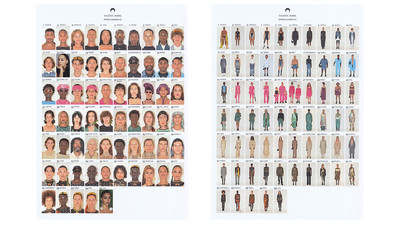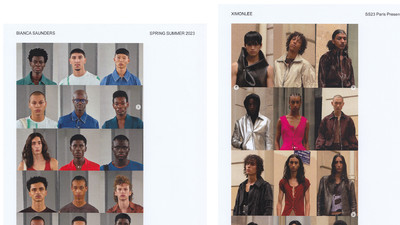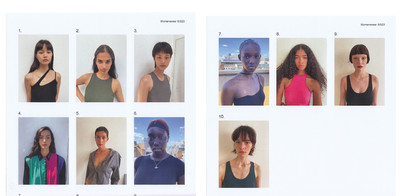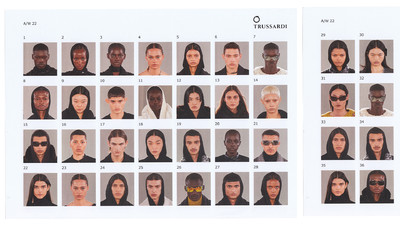From Bianca Saunders to Marine Serre and GmbH to Trussardi, five casting directors muse on what ‘diversity’ on the runway looks like.
By Dominic Cadogan
From Bianca Saunders to Marine Serre and GmbH to Trussardi, five casting directors muse on what ‘diversity’ on the runway looks like.
Objectively, when looking at casting in fashion, it’s easy to say that we’ve come a long way from the days of runways solely featuring svelte, Eurocentric faces. The era of size zero may have been outlawed, yes, and we may often see plus-sized models, a variety of gender identities and sexualities, occasionally even a wheelchair-user – but, rather than leaps ahead, to describe the movement as a tentative shuffle forward would be more apt.
Diversity, inclusivity, representation – whichever of the buzzwords fit in this instance – seems simple enough, yet, it’s a difficult line to toe, choosing a cast that feels genuinely inclusive, rather than a box-ticking exercise of as many marginalised identities that you can think of.
While naysayers may whine about the ‘glamour’ and ‘fantasy’ of fashion being lost, if fashion can hold up a mirror to reflect the tumultuous times we live in, it doesn’t feel like a stretch to ask it to represent the faces we see out in the world every day. After all, the faces a brand chooses to cast (or alternatively, the ones it doesn’t) say just as much about it as the clothes do.
However, a new generation of casting directors are emerging, vying for change, letting their work speak for itself. What does diversity look like to them? Look no further than the faces they’ve cast at brands including Bianca Saunders, Marine Serre, GmbH, Ahluwalia, and Trussardi.
Here, System speaks with five casting directors – Troy Fearn, William Lhoest, Conan Laurendot, Nicolas Bianciotto, and Affa Osman – on their personal approaches to casting for fashion week, how the industry is changing, and what the faces they find say about them.

What is your preparation process when fashion week is approaching?
Troy Fearn: I get a good trim, make sure my snack cupboard is stocked up, and re-up our stationery kit with labels, pins, and marker pens.
What is usually the starting point when you’re casting for a show? Do you have a team assisting you or prefer to work solo?
Troy Fearn: When starting out with a new brand, I like to have a conversation on who the brand is, who their customer is, and what they are creatively expressing – what’s the message? From here, I develop a model identity and any project that comes after is then built from this reference point. There’s a thread that runs throughout and a cohesive uniformity.
Where do you find faces for the show? Do you only cast agency models or street cast/social media? Do you have a preference for finding models?
Troy Fearn: No two shows are the same and it all comes down to what the client wants. For Ahluwalia, we’re looking for striking and beautiful models, people who can storm the runway and elevate the clothing, and then we have designers like Saul Nash whose work is informed by dance and movement. For Saul, it’s important for his community to be reflected in his shows so we’re scouting online, at dance schools, and sometimes even up in the club. We’re adaptable and commit to whatever is needed.
How does casting for shows differ from editorials/campaigns/other projects?
Troy Fearn: For shows/campaigns/lookbooks we host a live casting with the client. Together with the stylist, we call in models to try them in different looks and see which person best embodies the collection. For editorials, we’re usually working from model polaroids and self-tapes.
‘My work is an extension of myself and there’s a little of me in each project I put out. It’s diverse, it’s inclusive, it’s representative of the time, and it’s a place where people can see themselves reflected.’
What do you think the faces you cast say about you?
Troy Fearn: My work is an extension of myself and there’s a little of me in each project I put out. It’s diverse, it’s inclusive, it’s representative of the time but it’s classic, it’s fab, and it’s a place where people can see themselves reflected. We have a responsibility to leave behind something greater than what we first found and I think/hope the faces I cast do that.
What do you enjoy most about casting?
Troy Fearn: I love a fashion week casting and seeing the clothes come alive. We catch a vibe in the studio and it’s so nice to see everything come together at once.
What is your most memorable casting moment?
Troy Fearn: There have been so many highlights in my career that it would be near impossible to pick a most memorable casting moment. One of my favourite recent shoots would be my W magazine story with Rafael Pavarotti and Ib Kamara. This was headed up by the icon Jawara who created these insane hair sculptures working with the idea of hair in motion to represent change. This was shot as we were coming out of Covid with the idea of moving out of the dark times and leaving uncertainty behind which I think we can all relate to.
How have you seen the casting industry change throughout your career? How would you like to see it change in the future?
Troy Fearn: I see more and more brands are more aware of their creative output and the importance of diverse casting and representation. What’s important now though is to remember that Blackness is not a fad and for the greater industry to be mindful of not trying to define Blackness by what is trending at that moment. I would like to see the model agencies extend their scouting further than South Sudan and for there to be more inclusivity across all ethnicities.

What is your preparation process when fashion week is approaching?
William Lhoest: Getting a lot of sleep cause I know some sleepless nights are ahead of me.
What is usually the starting point when you’re casting for a show? Do you have a team assisting you or prefer to work solo?
William Lhoest: The start of any casting is an open discussion with the brand and the stylist. I do everything solo, it’s hard for me to delegate. I need to have a connection directly with the fashion house, agency, and talents .
How do you collaborate with the designer/s? Is there a specific brief you’re given or do you work more spontaneously?
William Lhoest: They explain the spirit of the collection and their vision to help me understand what types of models/talents I should find to represent that. I wouldn’t say it’s a specific brief, but they can have a really precise idea of what they want or pretty much be open about all my submissions. It’s teamwork and that makes the line-up more personal as everyone feels involved in it.
Where do you find faces for the show? Do you only cast agency models or street cast/social media? Do you have a preference for finding models?
William Lhoest: I’m from the new generation of casting directors, so I’m looking for talent everywhere (agencies/street/social media) – not that the new generation invented that, Jean Paul Gaultier was doing it a while ago.
I’m a former scout for modelling agencies, I’ve never assisted any casting directors or learned the job beforehand. A brand asked me to be their casting director because they had heard about my work as a scout, so naturally, when I started, I was more into streetcasting and social media casting. It allowed me to find talents that are now doing amazingly in the industry and working with other casting directors which has really validated my eye and work.
‘I’ve never been about finding the ‘new face of the season’ that disappears the next season. I want the talents I find to be able to have a career.’
How does casting for shows differ from editorials/campaigns/other projects?
William Lhoest: It’s really two different jobs to be a show model and an editorial/campaign one. Talents can be both, but somebody who is great for shows is not necessarily good for campaigns or editorials. Being photogenic is key for a campaign/editorial, but for a show it’s the attitude that makes all the difference.
What do you think the faces you cast say about the brand?
William Lhoest: I think they feel involved in and become part of the brand. I’ve never been about finding the ‘new face of the season’ that disappears the next season. I want the talents I find to be able to have a career because they often put their life on hold to pursue a career in fashion. For each of my clients, I try to build a bond between them and their models. Naturally, when you like someone and share common interests, you want to work with them often because you have fun together and work should always be fun!
What is your most memorable casting moment?
William Lhoest: I have a lot of memorable ones – funny stories and meeting people I look up to – but I think what stands out (it’s super cheesy) is at the end of every show when everybody is clapping. It makes me really emotional, it’s stressful but there is a lot of relief that everything went well and everyone is proud of what has been accomplished. It’s the end of at least six months of intense work.
What are some of the challenges you face casting for a show?
William Lhoest: The paperwork! In France, there is really strong legislation regarding shows and it takes a lot of paperwork and time.
How would you like to see it change in the future?
William Lhoest: I would love for tokenism to disappear and to see real inclusivity/diversity everywhere.

What is your preparation process when fashion week is approaching?
Conan Laurendot: I am always on the lookout for new faces: on the streets and by submitting pre-casting requests. I really try to be on top of things well in advance of fashion week in order to make things as smooth as possible when the time comes. The most important, though, is to stay healthy to be in the best shape for this intense seasonal work!
Do you have a team assisting you or prefer to work solo?
Conan Laurendot: As I’m working on several shows, I have a wonderful team helping me – I couldn’t do it alone!
How do you collaborate with the designer/s? Is there a specific brief you’re given or do you work more spontaneously?
Conan Laurendot: For each designer there is a different brief as the casting should reflect the identity of the brand. I do like to add my touch to it, but I also take into account the fact that each designer imagines their clothes for specific kinds of people.
‘There is still a lot to do in terms of inclusivity and ethics – I would love to see fashion representing society for real.’
How has your casting process evolved over time?
Conan Laurendot: For a long time, I was assisting top-notch casting directors who only worked with agency signed models, yet in the same time, I have run some streetcasting on the side for the projects I found personally interesting. My way of working evolved alongside the experience in both fields.
What do you think the faces you cast say about the brand?
Conan Laurendot: The faces say a lot about the representation the brand seeks on the market as well as about the level of inclusivity they want to identify with.
What do you enjoy most about casting?
Conan Laurendot: I love the variety of people I meet as well as the presence of beauty in my immediate surroundings. I am passionate about the concept and ideas of beauty in general.
How have you seen the casting industry change throughout your career?
Conan Laurendot: I’ve seen it evolving. There is wider representation of different body types and ethnicities both for men and for women. Yet, there is still a lot to do in terms of inclusivity and ethics – I would love to see fashion representing society for real.

What is usually the starting point when you’re casting for a show? Do you have a team assisting you or prefer to work solo?
Nicolas Bianciotto: We’ve always worked as a team, the key has always been about communication and sharing the workload. We’re really collaborative and every member of the team is free to give their opinion.
How do you collaborate with the designer/s? Is there a specific brief you’re given or do you work more spontaneously?
Nicolas Bianciotto: We usually talk a lot about their vision, their creative process and we go from there. It really depends on the brand or the creative team. Sometimes they already have a really clear vision of what they want and our job is to help them reach it and sometimes they allow us a bit more freedom.
This season, we worked on three different projects, all of them being close to us. Jeanne Friot is a promising, young designer with a strong vision and she’s doing a digital project. She has a very specific aesthetic, so it was more about helping her with her vision to elevate the casting. Reese Cooper is a close friend, we cast his first show in Paris and unfortunately due to the pandemic and him being based in LA, he had to pause showing, but this season he’s coming back. We wanted to hit it hard on this one, it was a mixed show and we always try to help him get the coolest models of the season, it’s very modern. Then NameSake we were introduced to through a close friend. The show was storytelling based on the designer’s experience and the looks evolved with the music, so we adapted the cast accordingly.
Where do you find faces for the show? Do you only cast agency models or street cast/social media? Do you have a preference for finding models?
Nicolas Bianciotto: It really depends on the project, but we do go-sees all year long to meet all the models that are coming through Paris. To prepare for the show season, we go through show packages and select our favourites. We like to use unseen faces and we’ve been doing a lot of streetcasting in our work for the past two years. It brings an edge and I’m bored of seeing the same line-ups for every show, so it’s also a good way to add more diversity.
‘Nowadays, casting directors are more aware of the responsibility they have to represent everybody. We embrace diversity in all its forms, beauty is not defined by one standard.’
How has your casting process evolved over time?
Nicolas Bianciotto: It hasn’t changed much, our vision has always been about inclusivity and diversity, even before it was a ‘trend’. We’ve always pushed forward that vision whether it was through models in agencies or people we found while street casting or social media.
How does casting for shows differ from editorials/campaigns/other projects?
Nicolas Bianciotto: It’s much more intense, you see around 200 models during casting days, you have to handle the fittings after that, options on probably 50 to 100 models if you need 40 to 60 models to walk the show, conflicts with timing and other shows. It’s hectic but always fun.
What do you think the faces you cast say about the brand?
Nicolas Bianciotto: They represent the identity of it, they’re the first thing people will remember about a project or the brand itself. We do our best to bring positivity and a clear vision of what the brand stands for.
What do you think the faces you cast say about you?
Nicolas Bianciotto: That we embrace diversity in all its forms and that beauty is not defined by one standard.
What is your most memorable casting moment?
Nicolas Bianciotto: The first presentation we did with Virgil for the launch of Off-White – seeing Virgil pursuing his dream to show a real ready-to-wear collection in Paris.
What do you enjoy most about casting?
Nicolas Bianciotto: The creative process and the fact that every day is different. There’s no routine in this job and every project is special in its own way.
How have you seen the casting industry change throughout your career?
Nicolas Bianciotto: The Black Lives Matter movement helped a lot with the representation of people of colour in the industry. Nowadays, casting directors are more aware of the responsibility they have to represent everybody.

What is your preparation process when fashion week is approaching?
Affa Osman: Fashion week is a rewarding but stressful time. For me, it’s important that I am in the right physical and mental head space leading up to the weeks before shows, it gives me a sense of control so that stressful times don’t get under my skin. People behave in all kinds of ways during shows, but that doesn’t mean you can behave like a dick. It’s a wild time and you need to protect your peace at any cost.
What is usually the starting point when you’re casting for a show? Do you have a team assisting you or prefer to work solo?
Affa Osman: Usually, it starts with the designers giving you some sort of hint or key words, where they are going in the upcoming season. You normally don’t get to see the collection beforehand which makes it an exciting kind of nightflight. It’s mostly a nuance in casting, as the DNA of a brand should remain. The closer you get to the show things start to crystallise. If you’re lucky and get to work with brands for a long time of
period, it’s an amazing experience as you are not only starting to cast ahead of a show instead you are on the look-out throughout the entire year.
For example, casting for GmbH gives me incredible joy as it’s personal. I have an ongoing folder that I am constantly updating and every season some core guys remain, and we add some new ones. I also like to spend time outside my office ahead of shows. I split my time between London, Paris and Berlin and often try to work remotely and observe people. It gives me a sense of what’s happening in the world. It’s tricky and ultimately limiting to rely fully on Instagram.
How do you collaborate with the designer/s? Is there a specific brief you’re given or do you work more spontaneously?
Affa Osman: It really depends on the brand and the people you work with. It’s a relationship that needs to be built and nurtured. The longer you work with the designers, the more trust is there and the more you understand what’s important to them. Sometimes it feels like you can read their mind beforehand, sometimes they totally surprise or even shock you with their choices. Personally, I like the unpredictability of the process as long as you feel you are heading towards the same goals with the same core values.
Where do you find faces for the show? Do you only cast agency models or street cast/social media? Do you have a preference for finding models?
Affa Osman: I really try to look everywhere and that means: everywhere. Art openings, Turkish hair salons, supermarkets, clubs, subway, porn movies, Netflix series, the construction site next to my office. When you are young and trying to find your own voice, it’s important to look at places that people might not be looking at anymore. I have so often found someone in the most remote places. It’s then exactly that one talent, other people keep asking you about and when that kid ends up then doing other major things, it’s incredible to know that on a deeper level we have managed to open doors.
‘I would love to see more agents taking risks and being less political. You could say: More spine, less spin.’
How has your casting process evolved over time?
Affa Osman: Uncompromisingly trusting my instincts. At times we all get insecure about our work as it’s so personal. But learning to turn off the noise has changed everything. You could say casting is like meditation, with one tiny difference: You are totally focused, but on the outside.
How does casting for shows differ from editorials/campaigns/other projects?
Affa Osman: Shows are like a magnifying glass: they make everything very clear and visible. I really like the people I get to work with, and fashion week feels almost like this intense school trip where everyone works so hard with the same vision and goal. Everyone works with incredible dedication and you are reminded how good everyone is at what they do (or of the opposite, but then you probably don’t continue working together). Seeing your own peers thrive and succeed is really a hell of inspiration. On the other hand, working on editorials and campaigns feels a bit more isolated, since your job is mostly done before you shoot, so you miss that on-set magic.
What do you think the faces you cast say about you?
Affa Osman: It’s personal. It has much to do with who I am and the way I have experienced beauty through another lens in my youth, before society imposes on you what beauty means.
What are some of the challenges you face casting for a show?
Affa Osman: I would love to see more agents taking risks for especially young brands and really make an inclusive and exciting space. There are some incredible agents that have a sixth sense for when something is about to blow up, but some just sadly sleep on it and once things are going well, they want you to drop everyone else and work with them exclusively. I don’t believe in that; I am loyal to whoever is loyal to me.
How would you like to see the industry change in the future?
Affa Osman: That people follow their heart, gut, eyes, and sense of what’s the right thing to do instead of a vague feeling of what might give them an advantage to ‘move up’. You could say: More spine, less spin.